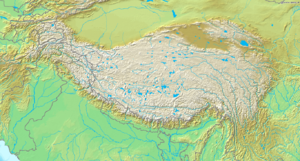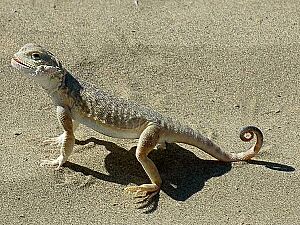Qinghai toad-headed agama facts for kids
Quick facts for kids Qinghai toad-headed agama |
|
|---|---|
 |
|
| Conservation status | |
| Scientific classification | |
| Genus: |
Phrynocephalus
|
| Species: |
vlangalii
|
The Phrynocephalus vlangalii, also known as the Qinghai toad-headed agama, is a special type of lizard. It's called a "toad-headed" lizard because of its unique head shape. This lizard is viviparous, which means it gives birth to live young instead of laying eggs. It is found only in the Tibetan Plateau in China. These lizards live in burrows they dig deep into the sand, high up in the mountains, between 2,000 and 4,600 meters (about 6,500 to 15,000 feet) above sea level. They are known for being quite feisty, especially the females during mating season. When they feel threatened, they curl their tails and show a colorful patch on their belly to scare off other lizards. They also have special bacteria in their stomachs that help them live in different mountain altitudes.
Contents
What Does It Look Like?
This lizard is quite small. It can grow up to 80 millimeters (about 3 inches) long from its snout (nose) to its vent (the opening where waste leaves the body).
Boy vs. Girl Lizards
Boy and girl P. vlangalii lizards look a bit different, especially when they are grown up. This is called Sexual dimorphism.
- Boys: Usually have bigger heads and longer tails. They have black tips on their tails.
- Girls: Tend to have larger bodies and longer bellies. They have orange tips on their tails.
Both boy and girl lizards use their tail tips and belly patches to defend their space from other lizards.
Size and Altitude
Lizards living at higher places on the Tibetan Plateau tend to be smaller. This is because the air is colder and has less oxygen at higher altitudes. Having a smaller body helps these lizards keep their body temperature steady and get enough oxygen.
Where Does It Live?
The P. vlangalii lizard digs burrows about 70 centimeters (about 2.3 feet) deep into the sand. These burrows are like safe homes, protecting them from predators and cold weather. Burrows deeper than 74 cm (2.4 feet) are especially good at keeping them warm.
Desert Home
These lizards live in dry, desert-like areas on the Tibetan Plateau. This area is known for being very high up, cold, and dry. Their love for desert homes means they can help scientists understand if grasslands are turning into deserts. This is called being an "indicator species."
Where to Find Them
You can find P. vlangalii lizards mainly in the Qinghai-Tibetan Plateau in China. Their home range stretches north to the southern Arjin mountains and the Gansu province in China. To the south, they reach the northern Tanggula Mountains and the southern part of the Yellow River.
Losing Their Homes
Even though there are many P. vlangalii lizards, their homes are shrinking. This is happening because of human activities and changes in the climate. When lizards lose parts of their habitat, especially at the edges of their territory, it can change how they act or even how they look.
Lizard Neighborhoods
These lizards live close together, with many lizards in one area. Each lizard usually has its own burrow, but their hunting and living areas often overlap. They guard their burrows because these are their safe spots from animals that might try to eat them. These lizards do not move to new areas; they stay in their home territories.
Family Tree and Types
There are other lizards that are very similar to Phrynocephalus vlangalii, like Phrynocephalus guinanensis and Phrynocephalus putjatia. Scientists sometimes debate how these lizards should be grouped. They look different, possibly because they have adapted to their specific homes. This might have happened millions of years ago when the Qinghai-Tibetan plateau rose, making many areas dry.
Scientists have identified two main types, or subspecies, of Phrynocephalus vlangalii:
- Phrynocephalus vlangalii hongyuanensis
- Phrynocephalus vlangalii vlangalii
Defending Their Space
Lizards are very protective of their burrows, which are the center of their territory. Both male and female lizards defend their space.
How They Defend
They use their tails to tell other lizards to stay away. They do this by:
- Coiling and lifting their tail: This shows off the black tail-tip for males and the orange tail-tip for females.
- Pushing up on their legs: This lifts their belly off the ground to show a colorful patch there.
Male lizards tend to coil their tails faster than females. Males also sometimes lash their tails, which females don't usually do. This tail lashing is fastest when a male faces another male. When an adult lizard faces another adult, their tail coiling is very tight and high. Younger lizards mostly wave their tails as a defense signal. Lizards with longer tails often have larger territories.
Some male lizards are "residents" and stay in one small area, defending it. Others are "floaters" and don't have a specific territory. Floaters might act differently to show they are not residents.
Reproduction and Life Cycle
Lizards start their courtship (when they try to find a mate) in May. Females give birth to their babies from mid-July to late August.
Growing Up
Most lizards grow faster in warmer places because they are ectothermic, meaning their body temperature depends on their environment. However, these lizards grow faster at higher altitudes. This might be because they are born larger and have more resources when they hatch in these high places. A female lizard usually has 2 to 6 babies at a time. Bigger female lizards tend to have more babies, and their babies are usually heavier.
Scientists did an experiment that showed lizards from high altitudes grow faster because they adapt to their environment, not just because of their genes. When lizards from high and low altitudes were raised in a lab, they grew at similar rates. This suggests that in the wild, their growth rate changes to help them survive in their different homes. More food at higher altitudes might also help them grow faster.
Mating Behavior
Boy and girl lizards usually don't fight each other much. However, girl lizards often fight other girl lizards.
Girl-on-Girl Fights
Girl lizards fight each other to find a mate because there are more females than males. They also fight to protect their territory and resources. Sometimes, male lizards help females defend their territory or protect them from other males trying to force them to mate. Forced mating can be dangerous for females, and some have even died from it. Female lizards who stay in one place (resident females) are quicker to show their coiled tail and belly patch to a rival if a male is nearby, especially during mating season. This fighting between females happens even when it's not mating season.
Girl-on-Boy Interactions
Since these lizards give birth to live young, females usually only have one mate. Having too many mates, especially forced ones, can be deadly for them. Female lizards might even guard their mates. Because females are very aggressive towards other females and don't like their territories to overlap, it's hard for males to have many mates. These lizards don't move around much, so they tend to live in groups that are related to each other.
Social Life
P. vlangalii lizards rely a lot on their burrows. These burrows protect them from predators and harsh weather, both in the active summer and the cold winter. Adult lizards live in separate burrows. Young lizards, about one year old, sometimes live in burrows that have been left empty or occasionally stay with their parents. However, this isn't very common.
Male lizards' territories often overlap more with female lizards' territories than with other males, especially if the male is healthy. Similarly, female lizards' territories overlap more with males than with other females. Each lizard usually stays in its own burrow, though some might use two or three burrows.
Gut Bacteria
Scientists studied the bacteria in the guts of P. vlangalii lizards from different altitudes. They found three main types of bacteria: bacteroidetes, firmicutes, and proteobacteria. As the altitude increased, one type of bacteria (verrucomicrobia) decreased, while another (bacteroides) increased. These bacteria are important for helping the lizard digest food and perform other body functions. The different types and amounts of bacteria help the lizards save energy on digestion when they live at higher altitudes. The lizards in this study lived at altitudes of 2,900 meters, 3,338 meters, and 4,250 meters.




